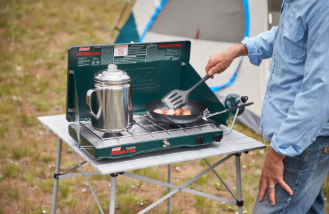How to Cook with Propane Gas
Cooking with propane has been a popular choice amongst people due to its efficiency, control, and convenience. When you own propane equipment, knowing how to use propane gas properly can greatly improve your cooking experience. This blog shares everything from setting up your propane tank to cooking delicious meals with it.

- Getting Started with Propane Gas
The first step in cooking with propane gas is to ensure you have a reliable source of propane. You can find propane tanks for sale at various locations, including propane companies near you. Consider factors like tank size (ranging from small propane tanks to 500-gallon propane tanks) based on your cooking needs and available space.
When searching for “propane delivery service near me,” look for reputable propane suppliers that have good reviews. These companies offer quality propane equipment and provide services such as propane delivery, tank refill, and tank installation.
- Setting Up Your Propane Tank
Once you have your propane tank, it’s important to set it up correctly. Ensure the valve of the tank is closed before connecting it to any appliances. Use appropriate fittings and hoses recommended by your propane supplier to prevent leaks.
For residential use, a common choice is a 100 lb propane tank or a 250-gallon propane tank. These sizes are a great option due to their capacity and space requirements. However, the tank sizes that you choose depend largely on your consumption. If you’re unsure about the best propane tank size for your needs, consult with your propane supplier for guidance.
- Cooking Techniques
Propane gas offers temperature control, making it ideal for various cooking techniques. Here are a few pointers you should follow to enhance your cooking experience:
- Preheat your grilling system: Preheat your propane grill to the desired temperature before adding food. Adjust the heat as needed throughout the cooking process to achieve perfectly grilled dishes.
- Observe flame color: Monitoring the color and size of your burner’s flame is important for safe cooking practices. Take a moment to observe the flame under your cookware. Ideally, it should burn blue. If you notice a yellow or orange hue, it’s advisable to call maintenance services.
- Maintain a low flame: Keeping a low and steady flame on your burner is recommended. Modern cookware conducts heat effectively, so it requires less flame for cooking. Maintaining a smaller flame reduces propane wastage and minimizes the risk of burning food.
- Safety Tips
While cooking with propane gas is efficient, safety should always be considered first. Here are some essential safety tips to keep in mind:
- Regularly inspect your propane tank connections for leaks.
- Keep flammable materials far away from the cooking area.
- Never use propane indoors unless the propane appliance you’re using is designed for indoor usage.
- In case of a gas leak, turn off the propane tank immediately and seek professional assistance.
- Maintenance and Refilling
To ensure uninterrupted cooking, monitor your propane tank levels regularly. Many propane suppliers offer propane delivery near you. Schedule refills before your tank runs empty to avoid interruptions during the cooking process. For commercial kitchens, consider a tank farm propane setup for efficient storage and refills.
- Environmental Considerations
Propane gas is a cleaner burning fuel compared to traditional fuel sources, making it an environmentally friendly choice. When searching for the “cheapest LPG gas near me”, consider buying from suppliers that prioritize eco-friendly practices and offer options of propane exchange delivery and commercial propane delivery.
Conclusion
Cooking with propane gas offers a range of benefits, as it offers precise temperature control and is environment friendly. By understanding how to set up and utilize propane tanks safely, along with using efficient cooking techniques, you can enhance your cooking experiences and enjoy delicious meals with ease.


